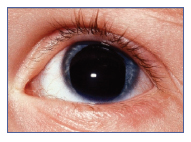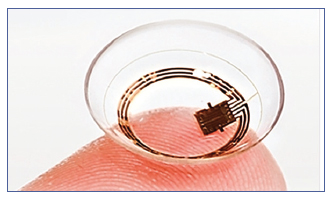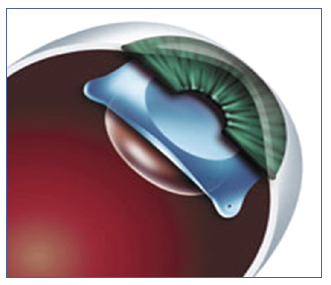Therapeutic Contact Lenses and Beyond
By Linda Conlin, ABOC, NCLEC
Release Date: May 1, 2018
Expiration Date: December 31, 2022
Learning Objectives:
Upon completion of this program, the participant should be able to:
- Understand the uses of contact lenses beyond vision correction.
- Learn how contact lenses are used in the treatment of eye injury and disease, as prosthetics and in drug delivery.
- Learn about the future of contact lenses for information and medical monitoring.
Credit Statement:
This course is approved for one (1) hour of CE credit by the National Contact Lens Examiners (NCLE). General Knowledge Course CWJHI002
This course is approved for one 1 hour CL CE credit by NYSSO
Therapeutic contact lenses are fit for several reasons. They are used to relieve pain from exposed nerve endings after damage to the cornea. They can protect and support an injured cornea as it heals. They can help maintain corneal hydration and are an effective mechanism for drug delivery.
Virtually any type of contact lens can be used as a therapeutic lens depending on the condition of the cornea. Rigid lenses are used in myopia control. Rigid scleral lenses are used when it's necessary to vault the cornea to promote healing. And soft lenses of varying water content are used as corneal bandages, for drug delivery and prosthetics.
 To fit a bandage contact lens when there has been trauma to one eye, it may not be possible to get a good keratometry reading from the injured eye. In those cases, a keratometry reading from the other eye will provide a guideline. Fit a lens that provides good coverage. Be sure there is enough lens movement to promote tear flow without interfering with surface cell regeneration. A larger, flatter lens works best unless the lens should not rest on the cornea at all.
To fit a bandage contact lens when there has been trauma to one eye, it may not be possible to get a good keratometry reading from the injured eye. In those cases, a keratometry reading from the other eye will provide a guideline. Fit a lens that provides good coverage. Be sure there is enough lens movement to promote tear flow without interfering with surface cell regeneration. A larger, flatter lens works best unless the lens should not rest on the cornea at all.
Medical applications for contact lenses include, among others, bullous keratopathy, corneal erosion, trichiasis, injury, photophobia and albinism. Let's take a look at how contact lenses help in each of these conditions.
Bullous keratopathy is a painful condition in which damage to the endothelial layer of the cornea results in permanent swelling. To help relieve the pain, fit a large highwater content lens with little movement to avoid rubbing the affected area.
With corneal erosion, pressure patching may be used for a large area of damage, but it means that the patient is temporarily monocular—a very uncomfortable situation. A thin low-water disposable lens can help keep the affected area medicated, reduce pain and protect the cornea from further erosion during blinking. It also allows the patient to use both eyes.
Trichiasis is the condition in which the eyelashes turn inward. The lashes then irritate and can scratch the cornea. A soft or rigid lens will serve as a barrier to protect the cornea from contact with the lashes.
If the cornea has a small, shallow laceration or has had surgery, a thin low-water content contact lens offers protection during healing.
Ocular albinism is characterized by reduced pigmentation of the iris and retina. Instead of normal eye color, the patient can appear to have red eyes or very light color, and the retina is much more susceptible to UV damage. The lack of pigment also results in extreme light sensitivity. Tinted UV-absorbing contact lenses offer protection from UV, reduce light sensitivity and can make eye color appear more normal.
Contact lenses can also provide relief for allergy sufferers. Daily disposable lenses that have built-in lubricants act as a barrier to irritants, reducing symptoms of itching, burning, stinging and redness.
 Appearances are important to just about everyone. Cosmetic contact lenses are used to mask or camouflage conditions like aniridia, pupil irregularities, permanent eye damage and amblyopia to improve the appearance and improve the quality of life for the patient.
Appearances are important to just about everyone. Cosmetic contact lenses are used to mask or camouflage conditions like aniridia, pupil irregularities, permanent eye damage and amblyopia to improve the appearance and improve the quality of life for the patient.
Aniridia is a condition in which all or part of the iris is missing. This also affects the size and shape of the pupil as well as the ability to constrict in bright light. As with ocular albinism, contact lenses can protect from UV, reduce light sensitivity and give a more normal appearance.
Aniridia can be a genetic condition or result from injury. When it's genetic, we need to be aware of associated disorders such as strabismus, nystagmus, and irregularities of the cornea and crystalline lens when considering a cosmetic contact lens. The artificial pupil in an opaque contact lens helps control light entering the eye and gives the eye a more natural look.
 In some cases, the contact lens fitter might want to consider custom contact lens designs. When the pupil appears more normal, a tinted lens with a clear edge may be enough to reduce light sensitivity and give the appearance of more normal eye color. If light sensitivity is the primary issue and the iris is intact and of acceptable color, a black, red, or sun lens pupil area in a clear lens can work well.
In some cases, the contact lens fitter might want to consider custom contact lens designs. When the pupil appears more normal, a tinted lens with a clear edge may be enough to reduce light sensitivity and give the appearance of more normal eye color. If light sensitivity is the primary issue and the iris is intact and of acceptable color, a black, red, or sun lens pupil area in a clear lens can work well.
Patching is a common treatment for amblyopia, but an occluder contact lens, which has an opaque center, can be just as effective, not to mention more comfortable and less obvious. This is especially true for young children who may pull or rub patches, or resist wearing eyeglasses with a frosted lens.
Prosthetic contact lenses can significantly improve the appearance of an eye after severe trauma or disfigurement.
Custom designs for prosthetic contact lenses are available, too. Depending on the individual case, the lens and pupil area can be tinted or opaque, and some custom lens manufacturers can match the color of the healthy eye.
 Let's take a look into the future to see how much more contact lenses can do. Things like drug delivery, health monitoring, myopia control and color vision enhancement are all on the horizon for contact lens applications.
Let's take a look into the future to see how much more contact lenses can do. Things like drug delivery, health monitoring, myopia control and color vision enhancement are all on the horizon for contact lens applications.
Did you ever see some of your patients try to apply eye drops? It becomes a very uncomfortable process with heads tilted way back, arms fully extended over their eyes and usually mouths wide open. It's a wonder that any of the drops actually get into the eye! Even if some of the drops hit the target, up to 95 percent can then be lost through the eye's normal drainage mechanism. Drug delivery through contact lenses can provide a steady and constant medication release, which is especially beneficial in cases of dry eye and glaucoma.
With drops, most of the medication is gone after just one hour, and none remains after eight hours. By contrast, a contact lens containing drugs is still delivering the medication after eight hours.
Not only can contact lenses deliver drugs, they can also monitor the levels of certain substances in the body that are found in tears. Glucose is one of those substances. It is important for diabetics to maintain constant blood glucose levels within normal range. Many diabetics also need vision correction, so a contact lens that not only corrects vision but monitors blood sugar is a great convenience. The lens can transmit the readings to remote devices for interpretation by a health care professional.
 The technology for this "smart" contact lens came from a compound used in smartphones, tablets and televisions. Dr. Gregory Herman of Oregon State University combined a transparent sheet of transistors from this compound with an enzyme that breaks down glucose and then embedded the sheet into a standard soft contact lens.
The technology for this "smart" contact lens came from a compound used in smartphones, tablets and televisions. Dr. Gregory Herman of Oregon State University combined a transparent sheet of transistors from this compound with an enzyme that breaks down glucose and then embedded the sheet into a standard soft contact lens.
This biosensor was adapted to detect the low levels of glucose found in tears. The enzyme, glucose oxidase, oxidizes the glucose, which changes the pH level of the tears. The change in the pH level changes the current flowing through the transistors. By tracking the changes to the current, glucose levels can be measured. A pretty amazing chain of events!
While these lenses aren't ready for testing yet, Dr. Herman doesn't want to stop there. He believes that the same technology can be used to monitor other bodily functions and to detect disease. Imagine the benefits of constant medical monitoring and early disease detection through the convenience of a contact lens!
We've all heard about the increasing incidence and progression of myopia in children. There are ways in which contact lenses can help control that progression. Current therapies include corneal refractive therapy—or CRT—under-correction, correction of peripheral hyperopic defocus and implantable contact lenses. Let's investigate those options.

In CRT, rigid lenses are worn overnight to flatten the central cornea. As you know with myopia, light focuses in front of the retina. Flattening the cornea shortens the distance to the retina, so the light will focus where it's supposed to. At the same time, peripheral images that focused behind the retina are brought forward. Experts believe that the images focusing behind the retina stimulate the eyeball to elongate, causing myopia. If the elongation of the eyeball can be slowed, it will also slow the progression of myopia.
So often we see our young nearsighted patients come back every year with a steadily increasing prescription. Rather than continue to increase the minus power of the lenses, studies have shown that reducing the accommodative demands of near vision with bifocal or multifocal lenses can slow the progression of myopia. Experts are uncertain as to whether the benefits of multifocal lenses are due to the better focus of light rays from near objects or better focus of peripheral images as suggested by peripheral hyperopic defocus. In either case, multifocal contact lenses alleviate the accommodative demands in young people and slow the advancement of their myopia as can multifocal eyewear, giving young people choice and flexibility.
Let's take a closer look at peripheral hyperopic defocus that I mentioned with CRT and under-correction. With myopia, central images focus in front of the retina, but at the same time, peripheral images focus behind the retina as in hyperopia.
The peripheral defocus may stimulate the eyeball to grow, which then causes myopia to progress.
Once again, contact lenses come to the rescue! CooperVision has developed the MiSight progressive design daily disposable lens that corrects peripheral defocus. Studies showed it slowed the progression of myopia in children by 59 percent.
 An implantable contact lens is a collagen-polymer lens that is implanted between the iris and the crystalline lens to correct vision. It's a good alternative for patients with very high myopia, or who may not be candidates for LASIK surgery.
An implantable contact lens is a collagen-polymer lens that is implanted between the iris and the crystalline lens to correct vision. It's a good alternative for patients with very high myopia, or who may not be candidates for LASIK surgery.
Now let's see how contact lenses can help with color vision deficiencies. To see color, the brain compares signals from the different types of cones in the retina. Defects in any of the cones affect color perception. The defects can be due to trauma, or they may be inherited. Genetic defects are due to visual pigments in the cones that are missing or incorrect.
There are two types of color deficiency: monochromats, who cannot distinguish any color, and dichromats who can distinguish some colors. Within dichromats, there are protanopes and deuteranopes who have red/green deficiency and trichromats who have blue/yellow deficiency. Notice the washed out or faded effect of the image on the left as seen by a dichromat.
Although nothing can replace the defective cones, red or magenta contact lenses have been used to enhance red light and absorb green light to help with color identification. Sometimes only one eye is fit with the lens. For people with light eyes, this may be cosmetically unacceptable. In that case, consider a contact lens with only the pupil area colored red or magenta.
 Just like the variety of sport-specific eyewear that's available, there is a variety of specialty contact lenses for sports to sharpen acuity in daytime conditions, e.g., when the wearer uses nonprescription clear lens goggles or shields for specific sports activities, high contrast amber contact lenses improve contrast sensitivity. Bolle blue contact lenses attenuate glare-causing blue light. Green contact lenses provide the high contrast of amber lenses, but without the color distortion. And yellow lenses provide high contrast in low light. Caution: Although colored contacts produce the same visual response as eyeglass lenses of the same tint/color, they do not provide the same protection for the whole eye and surrounding skin as a full sunglass. They do not provide full protection from harmful actinic ultraviolet radiation or high-energy violet/blue visible light, both of which are capable of producing a photochemical reaction that can result in cumulative and irreversible damage to the anterior and posterior eye. Full sunglass protection should always be offered to contact lens wearers—they can purchase plano sunglasses to wear over their contacts, giving them a broad selection of high fashion and sport sunglasses to choose from. Did I mention that contact lens wearers are the perfect sunglass second pair purchasers? Also keep in mind that most contact lenses do not provide full UV radiation protection making sunglass protection an important part of the contact lens wearer's vision care.
Just like the variety of sport-specific eyewear that's available, there is a variety of specialty contact lenses for sports to sharpen acuity in daytime conditions, e.g., when the wearer uses nonprescription clear lens goggles or shields for specific sports activities, high contrast amber contact lenses improve contrast sensitivity. Bolle blue contact lenses attenuate glare-causing blue light. Green contact lenses provide the high contrast of amber lenses, but without the color distortion. And yellow lenses provide high contrast in low light. Caution: Although colored contacts produce the same visual response as eyeglass lenses of the same tint/color, they do not provide the same protection for the whole eye and surrounding skin as a full sunglass. They do not provide full protection from harmful actinic ultraviolet radiation or high-energy violet/blue visible light, both of which are capable of producing a photochemical reaction that can result in cumulative and irreversible damage to the anterior and posterior eye. Full sunglass protection should always be offered to contact lens wearers—they can purchase plano sunglasses to wear over their contacts, giving them a broad selection of high fashion and sport sunglasses to choose from. Did I mention that contact lens wearers are the perfect sunglass second pair purchasers? Also keep in mind that most contact lenses do not provide full UV radiation protection making sunglass protection an important part of the contact lens wearer's vision care.
Researchers can now implant semitransparent LEDs in contact lenses. In the near future, TV or photo images will be projected directly to the eye. Contact lenses that display information are under development, as well as medical monitoring lenses like the glucose sensing lenses discussed earlier.
There is a contact lens that was named after a fish. The Triggerfish contact lens can monitor changes in intraocular pressure for glaucoma patients. While the fish is named for its ability to extend and release spines, the contact lens sensors make a pattern that looks similar to that of the fish.
This lens is already in use in other parts of the world. It records changes in the shape of the cornea at the limbus, which indicates a change in intraocular pressure. The sensors transmit the information to a recorder where it is stored and then can be sent to a practitioner for evaluation.
There are even smarter contact lenses. Contact lenses under development may be able to receive and display images. An antenna receives power from radio waves. The power is stored in an integrated circuit. The LED is in a tiny chip, and Fresnel lenses in the contact lens would allow the wearer to focus on an image literally on the cornea.
In 2016, Sony filed a patent for a contact lens camera. The camera has zoom and image stabilization features, as well as Wi-Fi and display. Imagine taking pictures with the blink of an eye!
A company called Innovega is developing contact lenses to work with augmented reality glasses. The FDA is currently reviewing the eMacula system that would provide vision correction and allow the wearer to focus on a tiny screen on the inside of the eyeglass lenses.
A combination of filters would send distance and near images to the retina simultaneously, but what happens when those simultaneous images get to the brain? Do we have the ability to separate them? Would we see both near and distant images at once?
At least one expert has doubts. Professor Gary Rubin speculates that some central and peripheral images may be lost and that a lack of coordination of eye and image movement may cause motion sickness. We'll have to wait to find out if he's right.
Did you ever think that contact lenses could be art? While an artist used lenses that are much larger than actual contact lenses, she used lens designs to reflect color onto multiple surfaces. I wonder how many other uses for contact lenses haven't been explored!
In summary, contact lenses aren't just for vision correction. They can provide health benefits, cosmetic benefits, control myopia, enhance vision, provide information, and you can bet there are more applications to come.
